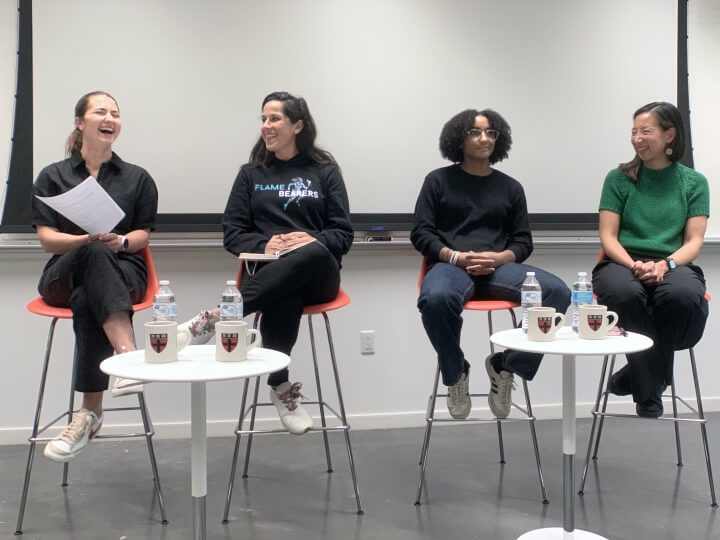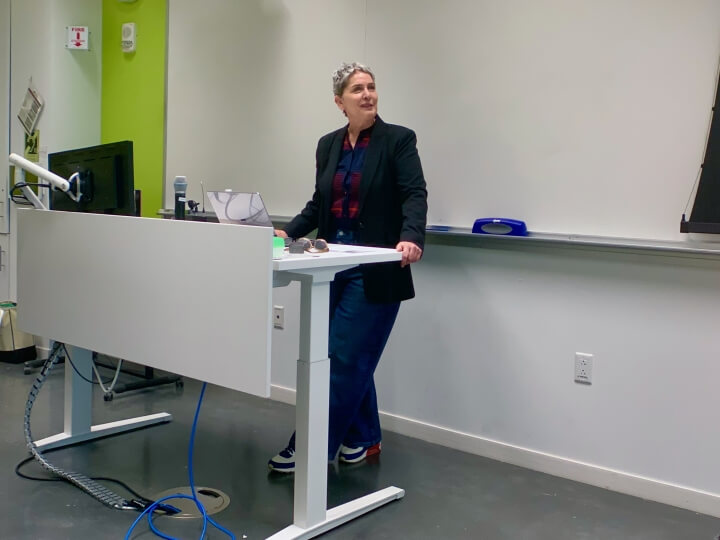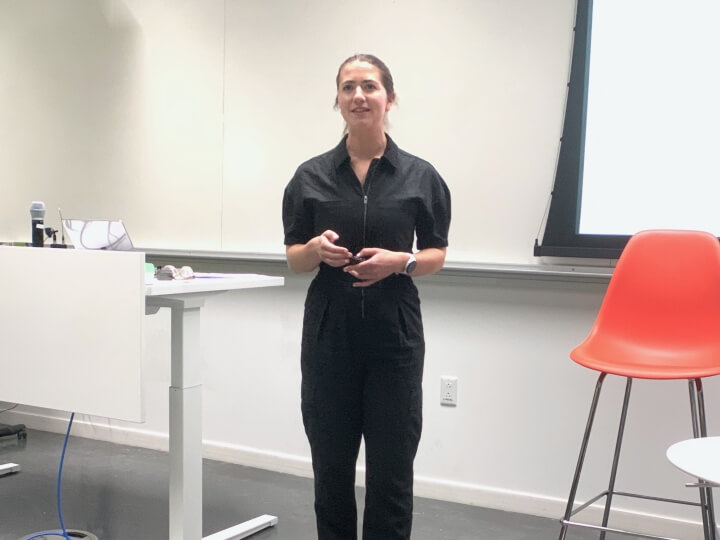News
Sara Falkson, MDE '25, leads panelists Jamie Mittleman, Lauren Scruggs and Christine Yu at “Inclusion by Design: Women in Sports.” (Matt Goisman/SEAS)
Much of the equipment and apparel used by female athletes could use an update. Tampon design hasn’t changed much since the product debuted in 1931, despite many women reporting discomfort wearing one while on the field. Female runners resort to any number of strategies to mitigate the lack of support in sports bras, from wearing two at the same time to undergoing top reduction surgery. Even locker rooms don’t take into consideration how scary a lack of privacy can be to a young girl beginning puberty.
Increasing the number of women in sports research and product design is a way to jump-start some much needed innovation in this space. That topic was explored at “Inclusion by Design: Women in Sports,” a Harvard Grid panel that recently took place at the Science and Engineering Complex at the Harvard John A. Paulson School of Engineering and Applied Sciences (SEAS).
“We must design products and places that are safe and inclusive,” said Sara Falkson, event host and Master in Design Engineering graduate student at SEAS and the Harvard Graduate School of Design (GSD). “Female designers must ascend into leadership roles to disentangle the gender design gaps and help athletes excel at every stage of life.”
Falkson led a panel of three women in a discussion of the state of women’s sports, touching on a range of topics including perceptions of female athletes, differences in quality in athletic venues for men and women, insulting and potentially dangerous approaches to women’s sports equipment design, and the lack of female athletes in research initiatives. The panel consisted of: Lauren Scruggs, a fourth-year philosophy concentrator and member of the Harvard women’s fencing team, who won an team gold and individual silver medal at the Paris Olympics; Christine Yu, journalist and author of Up to Speed: The Groundbreaking Science of Women Athletes; and Jamie Mittleman, founder of Flame Bearers, a media company dedicated to advancing the stories of female athletes.
“I’ve thought about the attitudes I’ve encountered but not so much the physical design,” Scruggs said. “It was really cool to hear about the research. It’s insane how many things are just not designed well for women. We’re so conditioned to be in poorly designed spaces that it becomes normal.”
We need female designers to flourish and move into these roles of influence and power, because women won’t forget that women exist.
Falkson, a former field hockey player at Dartmouth, became interested in the subject through her mentor Karen Korellis Reuther, Design Critic in Architecture at GSD. Reuther recently wrote about “Shrink It and Pink It,” a problematic approach to women’s product design that essentially takes products designed for men, reduces their size, changes the color to something more stereotypically feminine, then puts it back on the market without further consideration of the differences between male and female bodies.
Karen Korellis Reuther, Design Critic in Architecture at Harvard Graduate School of Design, speaks at “Inclusion by Design: Women in Sports” (Matt Goisman/SEAS)
“‘Shrink it and pink it,’ it goes down a continuum from insulting to deadly,” Reuther said in her introductory remarks. “Along the way, it’s expensive, uncomfortable and dangerous.”
“Women are not smaller men, and we have to start to look at and understand who we’re designing for. If you’re at the design table, how do you start to design equity into the process? Are we solving the right problems? We need female designers to flourish and move into these roles of influence and power, because women won’t forget that women exist.”
Discussed examples of insulting product design include the 2024 Olympic women’s track and field unitard, which was widely criticized as too revealing and not built for performance. Sports bras, meanwhile, can be so uncomfortable and unsupportive that women are left scarred.
“I’ve had the experience of having to wear two sports bras at once, and some women even undergo surgery because they think their bodies aren’t suitable for performance,” Falkson said. “Rather than changing ourselves, we must apply a female-athlete-centered design approach to reach our full potential.”
The first step to fixing this process could be to increase the number of women working in product design and athletic performance research. Both spaces are predominantly male, which can lead to undervaluing the specific needs of women’s physiology.
The National Library of Medicine conducted a study in 2022 and found that when it comes to sports supplements, studies on male athletes were eight times more common. This matters from an engineering and design perspective, because if you don’t have the data and don’t know who you’re building for, it’s going to be really hard from a design perspective.
That lack of data on female athletes can have a dangerous ripple effect. Poorly designed equipment can mean bad performances on the field. Bad performances can then lead to a perceived lack of quality in women’s sports, which turns away spectators and media coverage and can lead to reduced economic opportunities for professional female athletes. One example of this is in professional basketball, where the average salary for an NBA player is $12 million, while in the WNBA it’s $150,000.
Sara Falkson, MDE 25, speaks at "Inclusion by Design: Women in Sports" (Matt Goisman/SEAS)
“Cambridge and Boston are amazing university cities, and there’s a ton of research going on. When there are calls for research, put up your hands, fill out the surveys and volunteer,” Yu said. “If we want more research, we need more people to participate. What’s heartening to me is to see people interested in this, and to see a lot more people going into this field.”
This is the third “Inclusion by Design” event hosted by the Grid. Previous topics explored the lack of gender equity in the design of medical and personal protective equipment, and automotive safety.
“The idea of inclusion by design, or the lack of equity in how we think about design, has manifested itself in very broad and impactful ways in things we interact with and were largely unaware of,” said Paul Hayre, Executive Director of the Grid. “As engineers and venturers that employ science and engineering, the idea of bringing these concepts and a wider domain of thinking about use cases and who will use them is something that needs to happen at this stage, in these labs and in our minds, and not when we get devices into the market and realize we’ve designed something that certain populations have greater difficulty using.”
Topics: Design, Diversity / Inclusion, Health / Medicine, Master of Design Engineering
Cutting-edge science delivered direct to your inbox.
Join the Harvard SEAS mailing list.
Press Contact
Matt Goisman | mgoisman@g.harvard.edu





